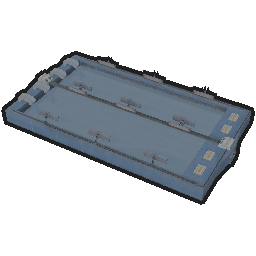Evaporation Pond (Heated): Difference between revisions
Thadius856 (talk | contribs) m →Recipes: +navbox |
Thadius856 (talk | contribs) m →Recipes: {{Recipe}} -> {{recipe define}} |
||
| Line 20: | Line 20: | ||
==Recipes== | ==Recipes== | ||
{{ | {{recipe define | ||
| Input1Name = Brine | | Input1Name = Brine | ||
| Input1Qty = 16 | | Input1Qty = 16 | ||
| Line 27: | Line 27: | ||
| Output1Qty = 8 | | Output1Qty = 8 | ||
}} | }} | ||
{{ | {{recipe define | ||
| Input1Name = Seawater | | Input1Name = Seawater | ||
| Input1Qty = 30 | | Input1Qty = 30 | ||
Revision as of 09:53, 29 January 2022
| Construction | |
| Workers | |
| Electricity | |
| Maintenance | |
| Footprint | 15x9 |
| Required Research | Salt Production |
| Designation | Water Extraction & Processing |
| Variants | Evaporation Pond |
The Evaporation Pond (Heated) is one of only two machines which can produce Salt, a critical ingredient in Glass Mix and a requirement to manufacture Glass. The other is the Evaporation Pond variant carries a 60% lower Worker, 33% lower Maintenance, and no Electricity cost, but also has a 75% lower throughput.
Salt can be created using either Seawater from a Seawater Pump or from the Brine byproduct of a Thermal Desalinator. Due to the greatly elevated Electricity requirements of Thermal Desalinators, production of Salt from Brine should generally only be considered if cases where there is already a supply of Brine which would otherwise be dumped back into the ocean, a significant source of excess non-polluting Electricity exists, or there are significant space constraints.
Recipes
| |
| |
| * Only available in the Supporter Edition | |
